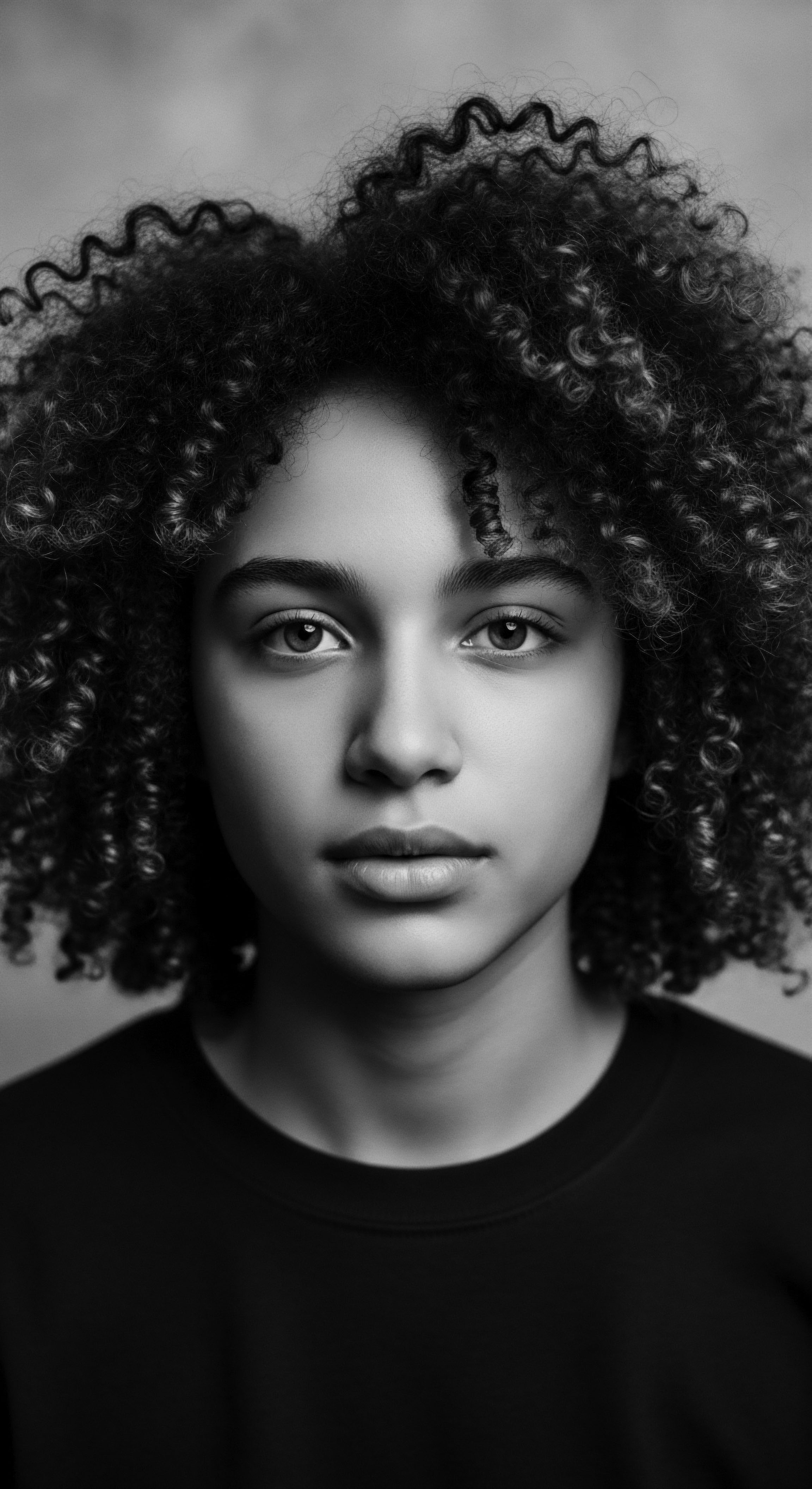
Fundamentals
The concept of Coiled Hair Science represents a profound meditation on the inherent characteristics and enduring wisdom held within hair strands that form spirals, curls, and waves. It is an investigation into the very fabric of textured hair, recognizing its distinct biological architecture and the rich heritage of care practices that have evolved alongside it across generations. This foundational understanding acknowledges that hair with a helical shape possesses unique structural properties, demanding a specific approach to its well-being.
This initial delineation of Coiled Hair Science begins with the elemental biology of the hair shaft itself. Unlike straight strands, which typically possess a round or oval cross-section, coiled hair exhibits an elliptical or flattened shape. This structural distinction, combined with the uneven distribution of keratin proteins within the hair cortex, dictates the strand’s tendency to coil upon itself.
The shape of the follicle from which the hair grows—often curved or C-shaped—plays a significant role in this natural spiraling. Each twist and turn in a coiled strand creates points of vulnerability, requiring specific consideration for its strength and moisture retention.
Beyond mere biology, the meaning of Coiled Hair Science extends into the ancestral knowledge systems that have long guided the care of textured hair. It is a recognition that communities with predominantly coiled hair textures, particularly those of Black and mixed-race descent, developed sophisticated methodologies for maintenance, styling, and adornment long before modern scientific inquiry. These practices, passed down through oral traditions and communal learning, represent a profound understanding of hair’s needs. The early caretakers intuitively grasped the importance of moisture, gentle handling, and protective styles, all of which align with contemporary scientific findings regarding the unique requirements of coiled hair.
Coiled Hair Science is the study of textured hair’s unique biological architecture and the ancestral wisdom guiding its care across generations.
To truly grasp the fundamental meaning of Coiled Hair Science, one must appreciate the inherent dryness often associated with coiled strands. The natural oils produced by the scalp, known as sebum, struggle to travel down the twists and turns of a highly coiled strand as effectively as they do on straight hair. This reality necessitates a deliberate and consistent focus on hydration and sealing in moisture, a principle deeply embedded in historical care rituals. The designation of “science” here does not merely imply laboratory experiments; it signifies a systematic body of knowledge, refined over centuries of lived experience and observation.
- Follicle Shape ❉ The curved or C-shaped follicle determines the elliptical cross-section of the hair shaft, which in turn causes the hair to coil as it grows.
- Keratin Distribution ❉ Uneven distribution of keratin proteins within the cortex contributes to the helical growth pattern, influencing the strand’s elasticity and curl definition.
- Moisture Path ❉ The spiraling nature of coiled hair makes it more challenging for natural scalp oils to coat the entire length of the strand, leading to inherent dryness.
Understanding Coiled Hair Science at its most basic level involves acknowledging these foundational aspects ❉ the biological blueprint of the hair itself and the environmental and hereditary factors that influence its texture. It is a departure from a singular, Eurocentric standard of hair, inviting a more inclusive and appreciative lens through which to observe and care for the diversity of human hair. This foundational explanation sets the stage for a deeper exploration of its cultural significance and advanced scientific dimensions.
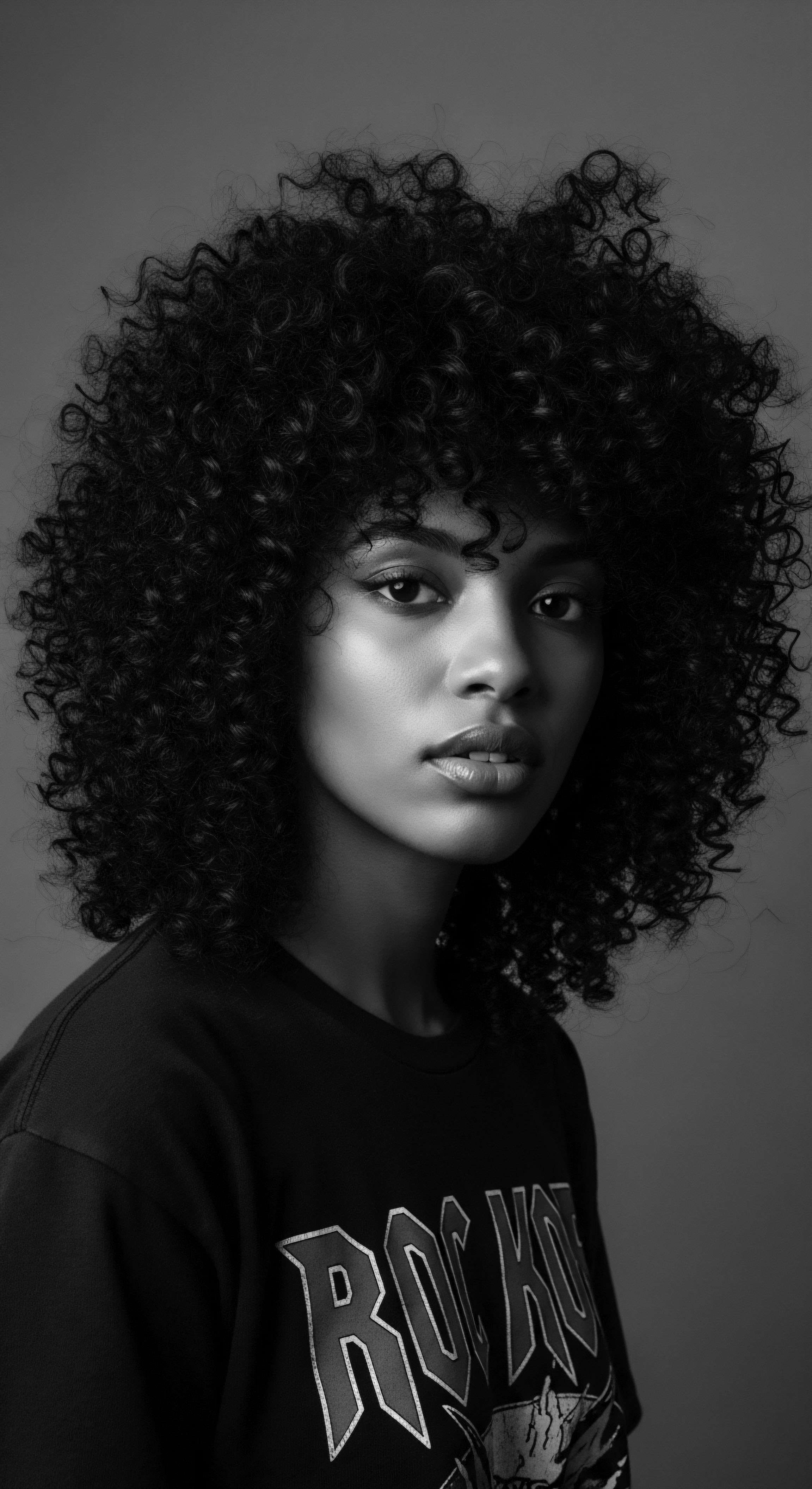
Intermediate
Moving beyond the foundational tenets, an intermediate understanding of Coiled Hair Science begins to delineate its significance as a dynamic interplay between biological predispositions and the accumulated heritage of human ingenuity. This level of comprehension acknowledges the complex structural components that render coiled hair distinct and the historical context that shaped its care traditions. It is here that we begin to see the profound connections between the strand’s microscopic architecture and the macroscopic rituals that have preserved its vitality for centuries.
The structural specification of coiled hair involves several layers of complexity. The cuticle, the outermost protective layer, consists of overlapping scales. In coiled hair, these scales tend to be more raised and open, particularly at the curves of the helix. This characteristic, while allowing for greater absorption of moisture, also means increased susceptibility to moisture loss and external damage.
The cortex, the central part of the hair, contains bundles of keratin fibers. In coiled hair, these fibers are arranged in a more asymmetric fashion, contributing to the curl pattern and influencing the hair’s strength and elasticity. The innermost layer, the medulla, is often discontinuous or absent in finer coiled strands, affecting overall robustness.
The meaning of Coiled Hair Science, at this intermediate phase, extends to the specific challenges and triumphs associated with its maintenance. Breakage, a common concern for individuals with coiled hair, often stems from the mechanical stress placed upon the hair during styling or detangling, especially at the vulnerable points of the coil. The history of hair care practices within Black and mixed-race communities, therefore, reflects a deep, experiential knowledge of mitigating these challenges. From the gentle art of finger-detangling to the strategic application of natural emollients, these ancestral methods speak to an intuitive grasp of hair mechanics and the need for tender handling.
Coiled Hair Science reveals how hair’s unique structure necessitates specific care practices, deeply informed by historical wisdom.
Consider the role of humidity in the daily experience of coiled hair. The raised cuticle allows coiled hair to readily absorb atmospheric moisture, which can cause the hair to swell and sometimes lead to frizz. However, this same property also means that coiled hair can be revitalized by humidity when properly moisturized.
This dual nature highlights a constant negotiation between environmental factors and internal hair health, a negotiation that traditional hair care rituals often addressed through ingredients and techniques designed to balance moisture levels. The interpretation of Coiled Hair Science at this level requires an appreciation for this delicate equilibrium.
The ancestral understanding of Coiled Hair Science is particularly evident in the historical use of specific botanical ingredients. Across the African continent and throughout the diaspora, various plant-based oils, butters, and herbs were employed not merely for cosmetic appeal but for their inherent properties that addressed the unique needs of coiled hair. These traditional remedies often provided deep conditioning, protection from the elements, and assistance with detangling, demonstrating a practical application of scientific principles long before they were formally codified.
| Traditional Ingredient (Ancestral Use) Shea Butter (West Africa ❉ Deep moisturizer, protective barrier) |
| Modern Scientific Understanding (Coiled Hair Science Link) Rich in fatty acids (oleic, stearic) and vitamins A and E; forms an occlusive layer to reduce transepidermal water loss, sealing moisture into the hair shaft. |
| Traditional Ingredient (Ancestral Use) Coconut Oil (Coastal Africa, Caribbean ❉ Penetrating oil, detangler) |
| Modern Scientific Understanding (Coiled Hair Science Link) High affinity for hair proteins, able to penetrate the hair shaft to reduce protein loss and aid in lubrication for detangling. |
| Traditional Ingredient (Ancestral Use) Aloe Vera (Across Africa/Diaspora ❉ Soothing, moisturizing) |
| Modern Scientific Understanding (Coiled Hair Science Link) Contains polysaccharides and glycoproteins that hydrate and soothe the scalp, contributing to a healthy environment for hair growth. |
| Traditional Ingredient (Ancestral Use) Chebe Powder (Chad ❉ Strengthens, retains length) |
| Modern Scientific Understanding (Coiled Hair Science Link) A blend of natural ingredients believed to strengthen the hair shaft and reduce breakage, assisting in length retention for highly coiled textures. |
| Traditional Ingredient (Ancestral Use) These historical practices exemplify an intuitive understanding of hair's biological needs, forming a profound legacy for Coiled Hair Science. |
The designation of Coiled Hair Science, in its intermediate exploration, thus encompasses both the detailed biophysical characteristics of textured hair and the sophisticated, often unwritten, historical practices that have guided its care. It bridges the gap between the microscopic world of keratin bonds and the expansive cultural landscape of hair rituals, underscoring the resilience and adaptability inherent in both the hair itself and the communities that celebrate its beauty.
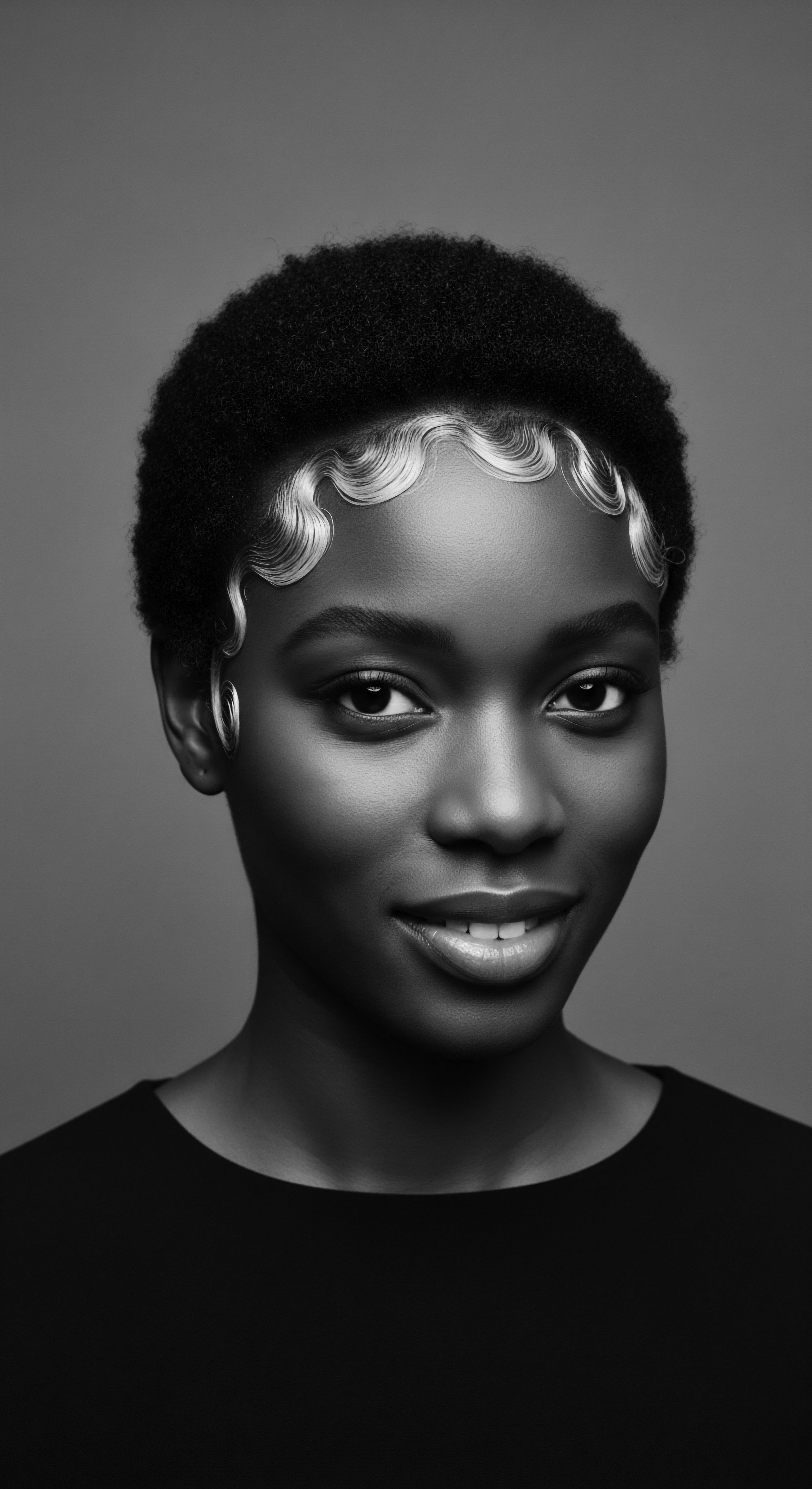
Academic
The academic definition of Coiled Hair Science represents a rigorous, interdisciplinary examination of the structural, mechanical, and socio-cultural dimensions of hair characterized by a helical morphology. This scholarly interpretation transcends superficial observations, delving into the precise biophysical mechanisms that govern coiling, while concurrently analyzing the profound historical and anthropological implications of textured hair within human societies, particularly those of African and diasporic descent. It is a systematic delineation that positions coiled hair not merely as a biological curiosity, but as a central artifact of identity, resilience, and inherited knowledge.
At its most granular, the academic explication of Coiled Hair Science centers on the trichological specificities of the hair shaft. The unique elliptical cross-section of coiled hair, coupled with the asymmetrical distribution of cortical cells (orthocortex and paracortex) within the hair fiber, dictates the intrinsic curvature. The differential growth rates and distinct mechanical properties of these cortical regions contribute to the hair’s propensity to twist and form spirals. This intrinsic torsion creates localized stress points along the fiber, rendering it more susceptible to mechanical damage from friction and tension.
The cuticle, often more raised and less tightly adhered in coiled hair, further compromises its protective integrity against environmental stressors and moisture efflux. Understanding these precise biophysical parameters is central to developing effective care strategies that respect the hair’s inherent vulnerabilities and strengths.
The academic meaning of Coiled Hair Science also extends to the complex interplay of genetics and epigenetics. While genetic polymorphisms in genes like EDAR and FGFR2 are associated with hair texture variations, the expression of these traits can be modulated by environmental factors and care practices across generations. This highlights a fascinating area of study where biological inheritance meets cultural adaptation. The very elasticity and tensile strength of coiled hair, often perceived as fragile, are in fact a testament to its unique engineering, allowing for diverse styling practices that have served both aesthetic and functional purposes throughout history.
Coiled Hair Science is an academic discipline examining the biophysical, mechanical, and socio-cultural aspects of helical hair, particularly its role in identity and inherited knowledge.
From an anthropological perspective, the significance of Coiled Hair Science is undeniable. Hair, particularly coiled hair, has historically served as a potent symbol of social status, tribal affiliation, marital status, age, spiritual connection, and ethnic identity across numerous African societies and their diasporic descendants. The intricate braiding patterns, the application of specific oils and clays, and the use of specialized tools were not merely aesthetic choices; they represented complex systems of communication and community cohesion. These practices, deeply rooted in ancestral wisdom, often possessed an implicit understanding of hair’s structural integrity and its physiological needs.
Consider the profound historical example of hair’s role in the Maroon communities of the Americas, particularly during periods of enslavement. In the face of brutal oppression, hair became a clandestine medium for survival and resistance, embodying a practical application of what we now understand as Coiled Hair Science. Enslaved African women, utilizing their deep, inherited knowledge of hair manipulation, ingeniously braided rice, seeds, and even gold dust into their intricate cornrow patterns. These styles, often appearing decorative to overseers, served as concealed maps and sustenance for escape routes through treacherous terrain.
The tight, durable nature of cornrows, a direct outcome of understanding coiled hair’s ability to hold tension and form lasting structures, allowed these vital items to remain hidden and secure during arduous journeys. This was not a casual act of styling; it was a sophisticated application of hair mechanics and material science, demonstrating an unparalleled ingenuity in the context of extreme duress. The very act of braiding, a communal practice often performed by women, became a silent act of defiance, a transfer of knowledge, and a tangible expression of hope for liberation. This specific historical instance underscores the multifaceted significance of Coiled Hair Science ❉ it is a biological reality, a cultural artifact, a tool of resistance, and a repository of ancestral genius. (Byrd & Tharps, 2014)
The academic inquiry into Coiled Hair Science also grapples with the historical imposition of Eurocentric beauty standards, which often demonized coiled textures, labeling them as “unruly” or “unprofessional.” This societal pressure led to widespread practices of chemical straightening and heat styling, resulting in significant damage to the hair fiber. Contemporary research within Coiled Hair Science, however, works to dismantle these harmful narratives by providing scientific validation for traditional protective styling methods and natural care regimens. It highlights the unique resilience of coiled hair when properly cared for, demonstrating its capacity for length retention and vitality despite historical attempts to suppress its natural form.
The Delineation of Coiled Hair Science from an academic lens requires a holistic methodology, integrating insights from trichology, anthropology, sociology, and even material science. It acknowledges the need for culturally competent research that respects the lived experiences of individuals with textured hair, moving beyond reductionist biological models to encompass the full spectrum of hair’s meaning and significance. This academic pursuit aims to not only understand coiled hair but to celebrate its complex beauty and affirm its rightful place as a subject of profound scholarly interest.
- Microstructural Analysis ❉ Examination of the hair’s elliptical cross-section, asymmetric cortical cell distribution, and cuticle morphology to understand intrinsic coiling mechanisms.
- Mechanical Properties ❉ Study of tensile strength, elasticity, and susceptibility to breakage at stress points along the helical fiber.
- Genetic and Epigenetic Factors ❉ Investigation into genetic predispositions for coiling and how environmental and generational care practices influence hair phenotype.
- Socio-Cultural Semiotics ❉ Analysis of hair as a non-verbal communication system, signifying identity, status, and cultural affiliation within historical contexts.
- Decolonization of Trichology ❉ Challenging Eurocentric norms in hair science and validating traditional care practices through scientific inquiry.
The deeper investigation of Coiled Hair Science, particularly through the lens of human experience, reveals long-term consequences of both understanding and misunderstanding. When coiled hair is recognized and celebrated for its inherent characteristics, individuals experience greater self-acceptance and a stronger connection to their ancestral heritage. Conversely, historical marginalization of coiled textures has contributed to psychological distress, economic disparities in hair care product development, and a disconnection from traditional practices.
The academic pursuit of Coiled Hair Science, therefore, is not merely intellectual; it is a critical endeavor with tangible implications for individual well-being and collective cultural affirmation. The insights gained from this comprehensive study have the potential to shape future product development, educational curricula, and societal perceptions, fostering a more inclusive and appreciative understanding of human hair diversity.
The continuous examination of Coiled Hair Science provides a comprehensive exploration of human ingenuity. It demonstrates how ancient communities possessed an intricate knowledge of their hair’s physical properties, using this understanding for practical survival and cultural expression. The resilience of these practices, enduring through centuries of displacement and cultural suppression, speaks volumes about their efficacy and deep cultural grounding. This advanced level of inquiry seeks to document, analyze, and disseminate this invaluable knowledge, ensuring its preservation for future generations and contributing to a more complete understanding of human biological and cultural adaptation.
The profound impact of Coiled Hair Science on self-perception and cultural continuity cannot be overstated. When individuals with coiled hair see their unique texture validated by scientific inquiry and celebrated through historical narratives, it contributes to a robust sense of identity. This affirmation counters generations of negative messaging and promotes a healthier relationship with one’s natural hair. The long-term success of this understanding lies in its ability to empower individuals to make informed choices about their hair care, rooted in both scientific understanding and ancestral pride.
The academic understanding of Coiled Hair Science also addresses the economic and social implications of hair discrimination. By providing authoritative information on the unique needs and properties of coiled hair, it supports legal and social movements advocating for hair freedom and challenging discriminatory practices in workplaces and schools. This rigorous academic grounding offers concrete data to support arguments for inclusivity and respect for diverse hair textures. The ultimate purport of this academic pursuit is to foster a world where coiled hair is universally recognized for its beauty, complexity, and profound cultural heritage.
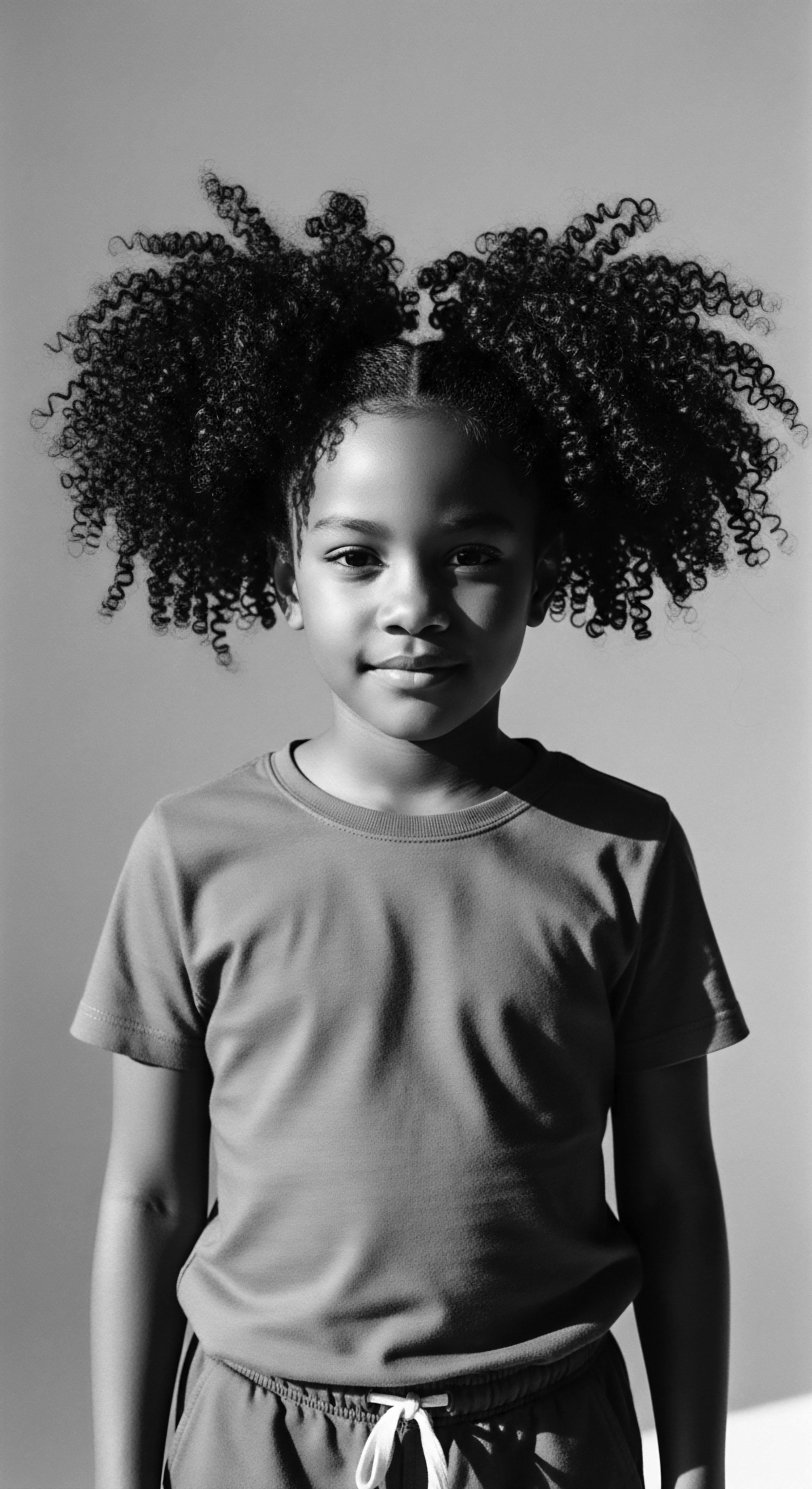
Reflection on the Heritage of Coiled Hair Science
The exploration of Coiled Hair Science stands as a testament to the enduring spirit of textured hair, a living archive of resilience and beauty. It is a profound meditation on the ‘Soul of a Strand,’ recognizing that each curl, coil, and wave carries the whispers of ancestors, the wisdom of ancient practices, and the vibrant pulse of contemporary identity. This journey from elemental biology to profound cultural significance underscores that understanding our hair is akin to understanding a vital piece of our collective story.
The heritage woven into Coiled Hair Science is not merely a historical footnote; it is a dynamic force that continues to shape daily rituals and expressions of self. It reminds us that the quest for healthy, vibrant hair is deeply intertwined with a reverence for those who came before us, who innovated and adapted with the resources available, passing down invaluable lessons through touch and oral tradition. Their meticulous care, often born of necessity and deep respect for the body, laid the groundwork for the scientific insights we now celebrate.
This continuous unfolding of Coiled Hair Science invites us to honor the past while looking towards a future where textured hair is universally celebrated in its natural glory. It calls upon us to recognize the deep connection between physical well-being and cultural affirmation, understanding that the health of our hair is inextricably linked to the health of our heritage. In every coil and every strand, there is a narrative of survival, creativity, and boundless beauty, awaiting discovery and profound appreciation.
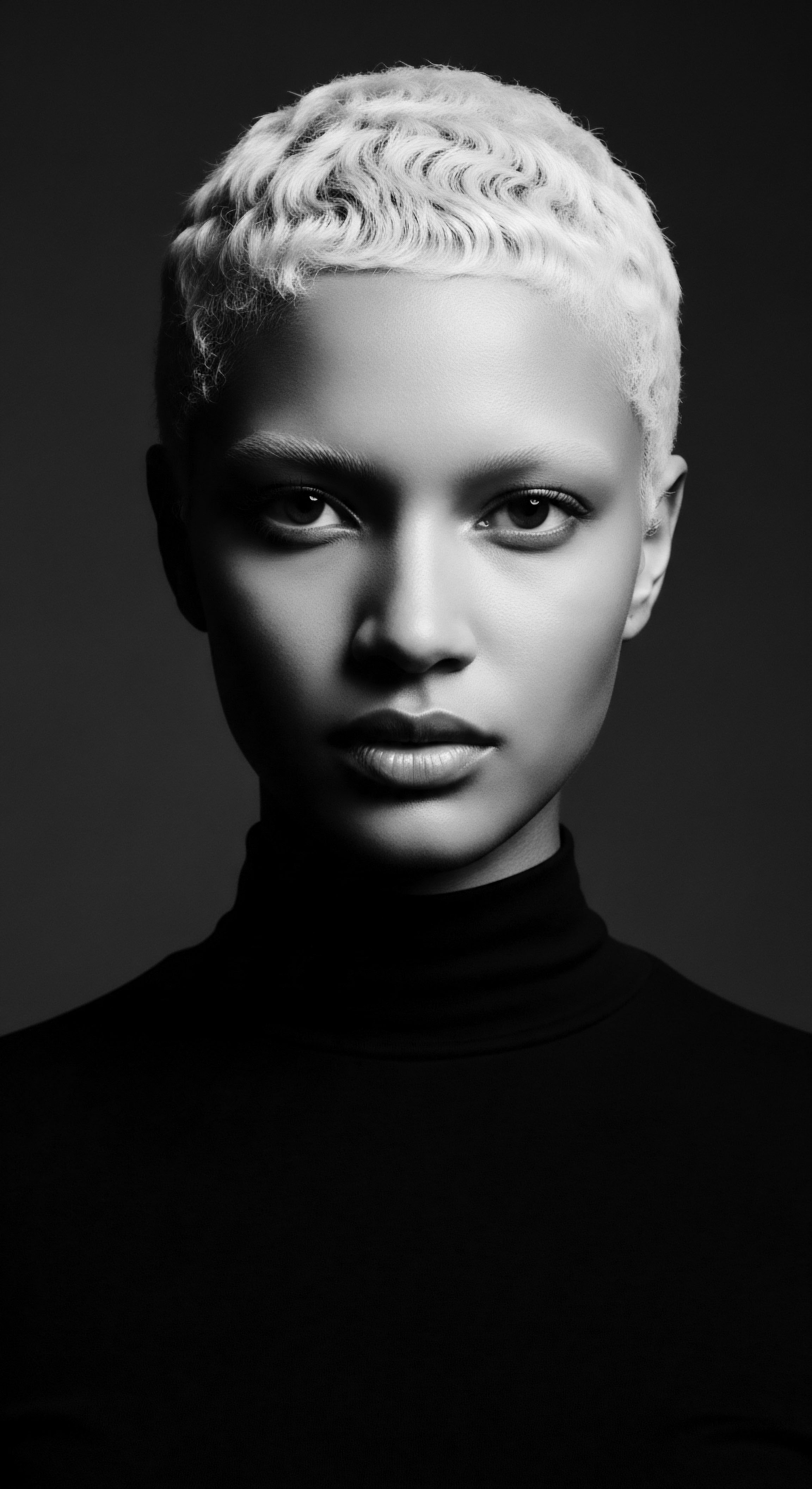
References
- Byrd, A. D. & Tharps, L. D. (2014). Hair Story ❉ Untangling the Roots of Black Hair in America. St. Martin’s Griffin.
- Gittens, R. (2018). Hair ❉ A Cultural History of Black Hair in Britain. Bloomsbury Academic.
- Mercer, K. (1994). Welcome to the Jungle ❉ New Positions in Cultural Studies. Routledge.
- Noli, L. & Farris, L. (2015). African Hair ❉ A History of Head Adornment in Africa from Antiquity to the Present. Skira.
- Robinson, A. (2016). The Curly Girl Handbook ❉ The Essential Guide to Caring for Curly Hair. Random House.
- Sherrow, V. (2006). Encyclopedia of Hair ❉ A Cultural History. Greenwood Press.
- Suggs, J. (2008). African American Hair as Culture. Praeger.
- Toby, M. (2015). Natural Hair ❉ The Ultimate Guide to African American Hair Care. Createspace Independent Publishing Platform.
